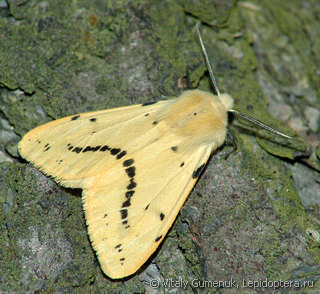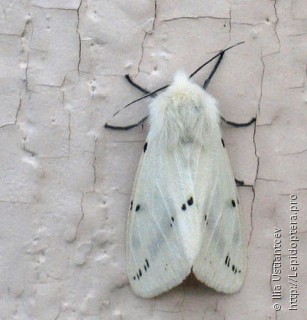Spilosoma lutea
Taxonomy
class Insecta
Species name(s)
Spilosoma lutea (Hufnagel, 1766) = Spilarctia luteum = Belciana siitanae (Remm, 1983) = Diacrisia lutea = Spilarctia lutea = Spilarctia lutea lutea. [3, 9, 10, 85]
Buff Ermine.
urn:lsid:insecta.pro:taxonomy:6681
Expansion
This species marks on the maps: 3.
Zoogeographical regions
Palaearctic.
Russia regions
#40. Primorsky.
Forewing length
18—20 mm.
Wingspan
34—42 mm.
Primary colors
Yellow, Brown/Gray/Black, White.
Flight time
| January | February | March | April | May | June | July | August | September | October | November | December |
Larva lifespan
| January | February | March | April | May | June | July | August | September | October | November | December |
Detailed information with references
Taxonomy, synonyms and combinations
Distribution
Imago Habitus and Differences from alike species
General info about Imago
Imago lifespan
Larva food plants / other food objects
Larva lifespan
Overwintering stage
Subspecies of Spilosoma lutea
- Spilarctia luteum japonicum (Rothschild, 1910). [9]
- S. l. luteum. [9]
- S. l. rhododactyla Bryk, 1948. [187]
Authors
Initial species uploading to the site: Peter Khramov.
Text data: Peter Khramov, Vasiliy Feoktistov.
The species characteristics formalization: Peter Khramov, Vasiliy Feoktistov.
References
- [1] O. Karsholt, J. Razowski (eds.), 1996. The Lepidoptera of Europe: a distributional checklist
- [3] Каталог чешуекрылых (Lepidoptera) России. Под ред. С. Ю. Синёва. СПб.; М.: Товарищество научных изданий КМК, 2008
- [9] Tree of Life (funet.fi), 2012
- [10] de Jong, Y.S.D.M. (ed.) (2011) Fauna Europaea version 2.4 (faunaeur.org)
- [28] Moths and Butterflies of Europe and North Africa (leps.it), 2012
- [85] Lepidoptera species catalogue, Lepidoptera.ru, 2015
- [187] Species 2000, http://www.sp2000.org
- [PC93] Vasiliy Feoktistov
Comments
Note: you should have a Insecta.pro account to upload new topics and comments. Please, create an account or log in to add comments
Spilosoma lutea photos














































All the photos of the species in large size
Please, create an account or log in to upload your photo





